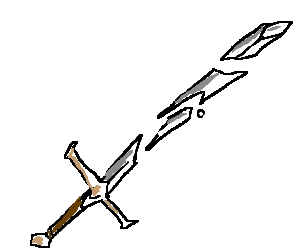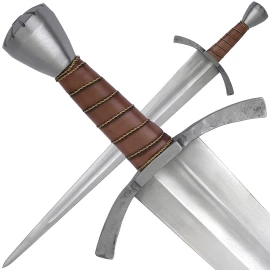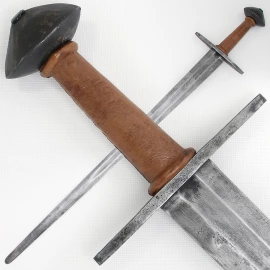Instruction manual to practical bladed weapons

Contents
The steel is really abrasion proof material. That´s why it is convenient for parts of a weapon such as the blade of a sword while the handle is covered in leather, which is tanned and dyed in accordance with the opinion of the General health officer of 31.10.2000.
It is forbidden to use sharp bladed replicas for fencing. We regard a sharp blade to be any blade with an edge (hitting edge) thinner than 3 mm. In other ways, such weapon’s other features are the same as in blunt varieties of weapons. We offer the above-mentioned just as decorative objects and we strictly forbid their use when fencing due to high risk of danger which goes with it.
When using the weapons, it is essential to wear at least the following protective clothing:
- a fencing mask made either of fabric or wire covering the whole head and neck.
- protective glasses with a side protection according to the EN 166
- a pair of leather gloves with a turnback covering the wrist. Leather should not be thinner than 1 mm.
- a quilted coat covering the whole arms and the body down under the crotch at least
- fixed leather boots with hard pointed toe and sole.
The size of protective clothing you wear must meet your size. They should not be damaged. We are not responsible for any wound or injury you suffer unless you use the recommended protective clothing!
When fencing, just weapons made by the same producer should be used. If not, use weapons with blades made of the same material and of the same hardness. Weapons were designed for a training and theatre fencing. Brutal and improper use (such as stabbing and knocking it into the ground, or forcing it) can easily damage even the best weapon!
A 2-year guarantee refers just to material faults and faults which appear when using the weapon in the proper way. In the way that follows these Directions. The guarantee does not refer to common wear out (being used every day intensively, the weapon can wear out within a few weeks).
Note: No knight would ever mistreat his sword since his life depended on it.
Fencing Recommendations:
- Do not attack using full strength, especially not when finishing the attack.
- Block your wrist when cutting in case your opponent does not fight off. (Do not unstretch wrist when completing the cut.)
- Do not stab in the axis of the weapon. When finishing the stab, transform it into a cut with the hitting edge at the weapon’s inside. (There is a blunt angle between the arm and the blade when completing the stab – the same angle which appears when cutting.)
- As blade hits the shield, unstretch the shoulder. Do not put any intensive pressure on the opponent’s shield. And do not block his counter pressure.
- Do not defend yourself using full strength. Check the tension and count on your opponent’s cooperation.
You can acquire these recommendations at a fencing school; taking lessons lead by a professional instructor. Preparing at a relaxed pace not hurrying up can help to gain
movement preciseness of all actions, together with respecting the safety rules. We strongly recommend to start using the sword after mastering technique using a wooden weapon. Under no circumstance should you produce an open battle!
Note: A good swordsman makes use of his technique – not strength!
Taking care of the weapon:
Clean, dry and conserve the weapon after using it every time. We recommend to use oil for weapons of WD40 oil for conservation. Remove the surface rust with abrading cotton or rubber. You can order these items from our supplies. Inspect the blade of the weapon after using it every time, as well. If you happen to find any material faults, send the weapon to us to have it repaired or exchanged. If any grots appear, they are a sign of a blade wear out. You can remove them with a diamond rasper or a grinding machine. Doing this, you will not only remove a saw effect that may result in a wound, but you will also show a great respect and responsibility to fencing, such a graceful and decent sport.



Comments